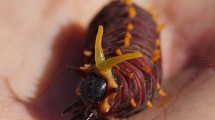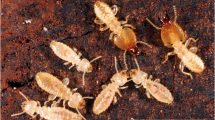Abstract
Soldiers of the neotropical humivorous termiteArmitermes chagresi have large ice-tong-like mandibles for mechanical defense and a moderate length nasus from which cephalic gland defensive secretions are discharged. Soldiers do not eject secretion, but ooze droplets which are held at the nasus tip by hairs. The chemical secretion is composed of C22–C26 macrocyclic lactones, including C24 and C26 and α- and β-hydroxylated lactones, with C24 macrolides predominating. The cephalic gland secretion has no pheromonal properties and does not induce alarm or attraction in soldiers or workers. Upon application, the secretion repels and is irritating to ants, but does not appear to act as an antihealant. The defensive behavior and chemistry ofA. chagresi is discussed in light of termite ecology and evolution.
Similar content being viewed by others
References
Albans, K.R., Aplin, R.T., Breheist, J., Moore, J.F., andO'Toole, C. 1980. Dufour's gland and its role in secretion of nest cell lining in bees of the genusColletes (Hymenoptera: Colletidae).J. Chem. Ecol. 6:549–564.
Cane, J.H. 1981. Dufour's gland secretion in the cell linings of bees (Hymenoptera: Apoidea).J. Chem. Ecol. 7:403–410.
Coles, H.R. 1980. Defensive strategies in the ecology of Neotropical termites. PhD thesis. University of Southampton. 243 pp.
Deligne, J., Quennedey, A., andBlum, M.S. 1981. The enemies and defense mechanisms of termites, pp. 1–76,in H.R. Hermann (ed.). Social Insects, Vol. 2. Academic Press, N.Y.
Deligne, J., andPasteels, J.M. 1982. Nest structure and soldier defense: An integrated strategy in termites, p. 282,in M.D. Breed, C.D. Michener, and H.E. Evans (eds.). The Biology of Social Insects. Westview Press, Colorado.
Duffield, R.M., Fernandes, A., Lamb, C., Wheeler, J.W., andEickwort, G. 1981. Macrocyclic lactones and isopentenyl esters in the Dufour's gland secretion of halictine bees (Hymenoptera: Halictidae).J. Chem. Ecol. 7:319–331.
Eisner, T., Kriston, I., andAneshansley, D.J. 1976. Defensive behavior of a termite (Nasutitermes exitiosus).Behav. Ecol. Sociobiol. 1:83–125.
Emerson, A.E. 1961. Vestigial characters of termites and processes of regressive evolution.Evolution 15:115–131.
Haverty, M. 1977. The proportion of soldiers in termite colonies.Sociobiology 2:199–216.
Kaib, M. 1982. Disruption of ant recruitment by the frontal gland secretion of a termite: A chemical defense strategy, pp. 385–389, M.D. Breed, C.D. Michener, and H.E. Evans (eds.).in The Biology of Social Insects. Westview Press, Colorado.
Mill, A.E. 1982. Foraging and defensive behaviour in neotropical termites. PhD thesis. University of Southampton. 264 pp.
Prestwich, G.D. 1979. Chemical defense by termite soldiers.J. Chem. Ecol. 5:459–480.
Prestwich, G.D. 1982. From tetracycles to macrocycles. Chemical diversity in the defense secretions of nasute termites.Tetrahedron. 38:1911–1919.
Prestwich, G.D., andCollins, M.S. 1981a. Chemotaxonomy ofSubulitermes andNasutitermes termite soldier defense secretions. Evidence against the hypothesis of diphyletic evolution of the Nasutiterminae.Biochem. System. Ecol. 9:83–88.
Prestwich, G.D., andCollins, M.S. 1981b. Macrocyclic lactones as the defense substances of the termite genusArmitermes.Tetrahedron Lett. 22:4587–4590.
Prestwich, G.D., andCollins, M.S. 1982. Chemical defense reactions of the termite soldiers ofAcorhinotermes andRhinotermes (Isoptera:Rhinotermidae): Ketones, vinyl ketones, and β-ketoaldehyde derived from fatty acids.J. Chem. Ecol. 8:147–161.
Prestwich, G.D.,Kaib, M.,Wood, W.F., andMeinwald, J. 1975, 1,13-Tetradecadien-3-one and homologs: New natural products fromSchedorhinotermes soldiers.Tetrahedron Lett. 4701–4704.
Prestwich, G.D., Bierl, B.A., Devilbiss, E.D., andChaudhury, M.F.B. 1977. Soldier frontal glands of the termiteMacrotermes subhyalinus: Morphology, chemical composition, and use in defense.J. Chem. Ecol. 3:579–590.
Quennedey, A. 1975. La guerre chimique chez les termites.La Recherche 6:274–276.
Stuart, A.M. 1982. The role of pheromones in the initiation of foraging, recruitment and defence by the soldiers of a tropical termite,Nasutitermes corniger (Motschulsky).Chem. Senses 6:409–420.
Thorne, B.L. 1982. Termite-termite interactions: Workers as an agonistic caste.Psyche 89:133–150.
Traniello, J.F.A. 1981. Enemy-deterrence in the recruitment strategy of a termite: Soldier-organized foraging inNasutitermes costalis.Proc. Natl. Acad. Sci. U.S.A. 78:1976–1979.
Traniello, J.F.A. 1982. The social organization of foraging in the Neotropical termiteNasutitermes costalis, p. 41,in M.D. Breed, C.D. Michener, and H.E. Evans (eds.). The Biology of Social Insects. Westview Press, Colorado.
Author information
Authors and Affiliations
Rights and permissions
About this article
Cite this article
Traniello, J.F.A., Thorne, B.L. & Prestwich, G.D. Chemical composition and efficacy of cephalic gland secretion ofArmitermes chagresi (Isoptera: Termitidae). J Chem Ecol 10, 531–543 (1984). https://doi.org/10.1007/BF00988098
Received:
Revised:
Issue Date:
DOI: https://doi.org/10.1007/BF00988098




